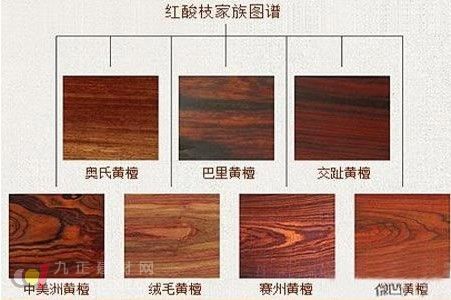As one of the major categories in the "Redwood" national standard, the red rosewood family includes several species such as Sian rosewood, A. sinensis, Diphong Dalbergia, Bari Dalbergia, Sai Dang, Sandalwood, and Central American Dalbergia—totaling seven types. But how can you distinguish between these different kinds of red rosewood? What are their unique wood characteristics? This article explores the various types of red rosewood, offering readers a comprehensive overview of this fascinating wood family.
Red rosewood is widely used in the production of mahogany furniture in China due to its excellent quality, abundant supply, and reasonable price. It's highly favored by furniture enthusiasts. However, with so many varieties under the red rosewood umbrella, the appearance of different species can be very similar, and price differences are often minimal. This makes it challenging for consumers when purchasing red rosewood furniture, leading to confusion and uncertainty.
Moreover, from a scientific perspective, identifying the exact tree species based solely on wood samples is difficult without additional botanical evidence like leaves. In other words, determining the specific type of red rosewood through lab testing is not always straightforward. It usually requires expert knowledge of the Dalbergia genus or other related species. Therefore, for buyers, understanding basic identification techniques has become an essential skill when purchasing red rosewood furniture.

Wood Industry Information Network Data Map: Detailed Explanation of Red Rose Family
The "Redwood" national standard outlines specific criteria for defining red rosewood:
- It must belong to the Dalbergia genus;
- The wood structure should be fine to very fine, with an average tube hole chord diameter not exceeding 200 μm;
- At 12% moisture content, the air-dry density should be greater than 0.85g/cm³;
- The heartwood color ranges from reddish-brown to purple.
In addition, the standard describes the characteristics of red rosewood: it typically has a loose to semi-diffuse growth ring pattern, with reddish-brown or purplish-red heartwood. The axial thin-walled tissue appears as concentric bands or narrow strips, and the wood has a fine texture. The air-dry density is high, and wave-like patterns may be visible. It often emits a faint acidic aroma, and most of the wood sinks in water. Radial surfaces may show distinct stripe patterns due to interlaced grain.
Through this description, we gain a basic understanding of red rosewood. By comparing the seven types, we can draw several conclusions:
First, all red rosewood must be species of the Dalbergia genus. Dalbergia is one of the five genera included in the "Redwood" national standard. The others are Pterocarpus, Swietenia, Millettia, and Diospyros. Among Dalbergia, three types are recognized: fragrant rosewood, black rosewood, and red rosewood. Of these, red rosewood is the most commonly used in furniture making.
Second, in terms of popularity, Sian rosewood is the most sought after, followed by Diphong Dalbergia, A. sinensis, and Bari Dalbergia. The remaining three—Saizhou Dalbergia, F. rosewood, and Central American Dalbergia—are rarely used in China.
Third, geographically, the main sources of red rosewood are Southeast Asia (Laos, Myanmar, Cambodia) and South America/Mexico. While Sian, Diphong, and Bari Dalbergia come from Southeast Asia, the others are mainly from South America and Mexico.
Fourth, historically, Cochin rosewood and Barry rosewood have been used in Chinese furniture for the longest time, followed by Albright rosewood, and finally, Diphong and American rosewoods.
Fifth, the wood color varies depending on origin. Southeast Asian species like Cochin, Albright, and Barry rosewood tend to have reddish-brown or purplish-red new sections. In contrast, South American and Mexican species like Sian, F. rosewood, and Central American rosewood often display a more vibrant red tone when freshly cut.
Finally, when comparing air-dry density, Sian rosewood has the highest at 1.20g/cm³, surpassing Barry, Cochin, and Albright rosewoods. Overall, understanding these distinctions helps buyers make more informed choices when selecting red rosewood furniture.
FOSHAN CITY KURUI LIGHTING CO.,LTD , https://www.kuruilighting.com